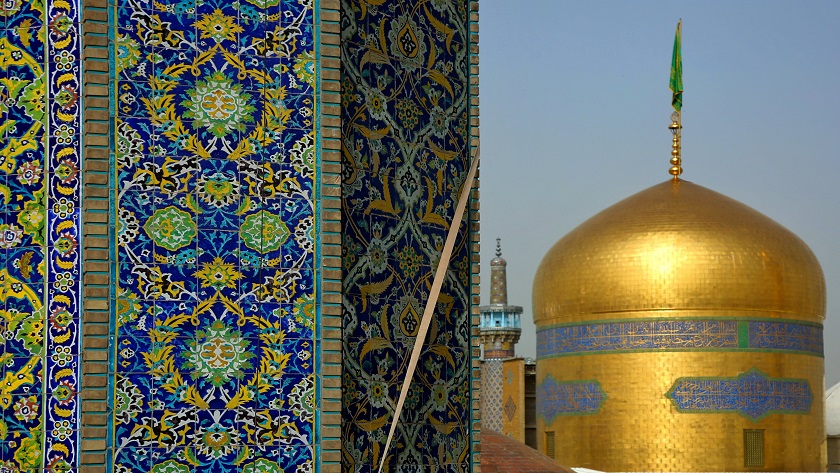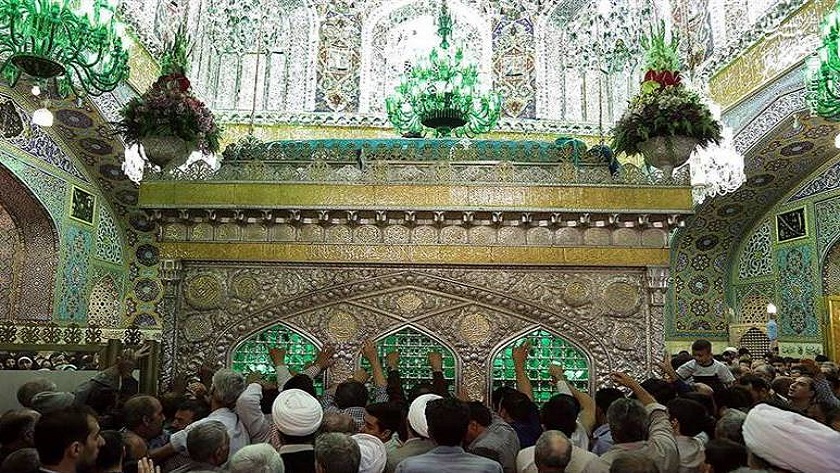Iran Press/ Iran news: The Imam Reza holy shrine (Sanctuary of Imam Reza) in Mashhad, Iran, is a complex which contains the mausoleum of Imam Reza, the eighth Imam of Twelver Shias. It is the largest mosque in the world by area. Also contained within the complex are the Goharshad Mosque, a museum, a library, four seminaries, a cemetery, the Razavi University of Islamic Sciences, a dining hall for pilgrims, vast prayer halls, and other buildings.
 Imam Reza holy shrine comlpex
Imam Reza holy shrine comlpex
Imam Reza (AS) Biogrphy
According to renowned historians and traditionists, Imam Reza (AS) was born on Thursday or Friday, Zul-Qa'dah 11 in the year 148 AH. Therefore, the year of his birth coincides with the martyrdom of his great ancestor Imam Sadiq (AS). The Imams’ names and epithets represent a special message. His noble name is Ali and his notable epithet is Reza and Abu al-Hassan.
 An old picture depicting Imam Reza wooden shrine
An old picture depicting Imam Reza wooden shrine
In 183 AH, with the martyrdom of Imam Musa al-Kazem, the Imamate of Imam Reza began. He was not more than 35 years old when he took over the affairs of the Imamate and was responsible for guiding the intellectual and doctrinal community of the Islamic ummah.
 Inside Imam Reza holy tomb
Inside Imam Reza holy tomb
Imam Musa al-Kazem (the seventh Imam of the Shia Muslims) introduced Imam Reza as the Imam and guardian after him on various occasions and took testimony from his companions and students on this crucial matter. The period of his Imamate lasted twenty years, of which seventeen years were spent in Medina and the last three years in Iran's Khorasan.
 Imam Reza is greatly respected by Iranian people and Muslims
Imam Reza is greatly respected by Iranian people and Muslims
The period of life and Imamate of Imam Reza is the period of the peak of people's tendency towards the Ahl al-Bayt of infallibility and purity and the expansion of their popular bases.
At the height of the people's desire for the eighth Imam of the Shia Muslims, Ma'mun, from the Abbasid Caliphate, conspired against Imam Reza and poisoned him, which led to his martyrdom.
 Imam Reza mausoleum; an architectural masterpiece
Imam Reza mausoleum; an architectural masterpiece
Architectural significance
The shrine is enveloped in a vast series of sacred precincts collectively known as the Haram-e Razavi, or Haram for short. This magical city-within-a-city sprouts dazzling clusters of domes and minarets in blue and pure gold behind fountain-cooled courtyards and magnificent arched arcades. It’s one of the marvels of the Islamic world, and it's worth savoring its moods and glories more than once by visiting at different times of the day.
 Islamic architectural elements are extensively used in the complex
Islamic architectural elements are extensively used in the complex
The great mosque of Goharshad is a remarkable Islamic structure due to its age, architectural characteristics and rich tile decorations. Made of brick and plaster in the 15th century, it used to be served as a free-standing mosque and currently serves as one of the prayer halls within the splendid Imam Reza Shrine Complex in Mashhad. On the margins of the main veranda’s entrance, there is an old inscription carved by calligrapher Baysunqur Mirza.
 The golden dome shines in the night sky
The golden dome shines in the night sky
The gilded dome, known as Qubba, regarding its height and structure is of exceptional quality. A double-shelled dome with Muqarnas underneath. The space between the two shells of the dome is almost 13.60 m high, while the height of the walls is 18.80 m. In total, the height of the structure from the ground level to the top of the dome is 31.20 m. On the plinths, exquisite octagonal tiles known as “Sanjari tiles”, from the Seljuq era (557 AH) are used.
 The turquoise color dome of Goharshad mosque resembles heaven
The turquoise color dome of Goharshad mosque resembles heaven
Goharshad mosque, of other significant historic architecture within the complex, due to its fine decorative arts and tiles is considered a masterpiece of Iranian Architecture from the Timurid era. The structure is built by the distinguished architect of Teimurid time, Qavam al- din ibn Zein al- din Shirazi by use of brick and gypsum in Islamic architectural style. The great mosque of Goharshad is an astonishing Islamic structure due to its age, architectural characteristics, and rich tile decorations.
 The gilded walls shine gloriously
The gilded walls shine gloriously
The construction started in 1418 by the order of Queen Goharshad, the wife of Shahrokh. The mosque took about 12 years to be completed under the supervision of capable Iranian architect Ghavameddin Shirazi by the use of the architectural and decorative manpower supplied from the Iranian cities of Shiraz and Isfahan.
 Fine Iranian art embellishes Goharshad mosque
Fine Iranian art embellishes Goharshad mosque
Covering an area of about 10,000 square meters, the mosque consists of a large azure dome, two 40-meter minarets, four verandas, a courtyard with seven big bed-chambers, and a large altar made of a stony dado and mosaic faience shell.
Standing in the courtyard one can recognize the ensemble’s cheerful color and solidity among the tower-like minarets, merging with the outer corners of the portal screen spreading to the ground together with the high foundation revetment of marble.
The entire court facade is faced with enamel brick and mosaic faience of the finest quality.
 Imam Reza shrine is a top destination for pilgrimage
Imam Reza shrine is a top destination for pilgrimage
Religious, cultural importance
Imam Reza’s holy shrine is the most significant element giving identity to the urban area of Mashhad. The city is of exceptional examples formed based on the shia’s and pilgrimage culture. From the spiritual point of view, the complex has significance regarding the traditions, and observing rites of the holy shrine.
The spiritual tradition of pilgrimage to the holy shrine of Imam Reza (AS) has been registered on the National Intangible Cultural Heritage List by Iran's Ministry of Cultural Heritage, Tourism and Handicrafts.
Read More:
Imam Reza shrine hosts world’s first Ahl al-Bayt library
World researchers to access Imam Reza shrine library
Ashkan Salehian

